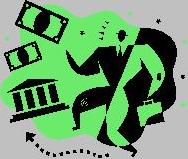
 |
|
| Financial Terms | |
| Money center banks |
|
Information about financial, finance, business, accounting, payroll, inventory, investment, money, inventory control, stock trading, financial advisor, tax advisor, credit.
Main Page: money, investment, inventory control, payroll, accounting, financial advisor, inventory, stock trading, |
Definition of Money center banks
Money center banksbanks that raise most of their funds from the domestic and international money markets, relying less on depositors for funds.
Related Terms:At-the-moneyAn option is at-the-money if the strike price of the option is equal to the market price of the Call money rateAlso called the broker loan rate , the interest rate that banks charge brokers to finance Commodities Exchange Center (CEC)The location of five New York futures exchanges: Commodity Consortium banksA merchant banking subsidiary set up by several banks that may or may not be of the Federal Home Loan BanksThe institutions that regulate and lend to savings and loan associations. The Hot moneymoney that moves across country borders in response to interest rate differences and that moves In-the-moneyA put option that has a strike price higher than the underlying futures price, or a call option  Money baseComposed of currency and coins outside the banking system plus liabilities to the deposit money banks. Money managementRelated: Investment management. Money managerRelated: Investment manager. Money marketmoney markets are for borrowing and lending money for three years or less. The securities in Money market demand accountAn account that pays interest based on short-term interest rates. Money market fundA mutual fund that invests only in short term securities, such as bankers' acceptances, Money market hedgeThe use of borrowing and lending transactions in foreign currencies to lock in the Money market notesPublicly traded issues that may be collateralized by mortgages and MBSs. Money purchase planA defined benefit contribution plan in which the participant contributes some part and  Money rate of returnAnnual money return as a percentage of asset value. Money supplyM1-A: Currency plus demand deposits New moneyIn a Treasury auction, the amount by which the par value of the securities offered exceeds that of Out-of-the-money optionA call option is out-of-the-money if the strike price is greater than the market price Precautionary demand (for money)The need to meet unexpected or extraordinary contingencies with a Reinvoicing centerA central financial subsidiary used by an MNC to reduce transaction exposure by having Speculative demand (for money)The need for cash to take advantage of investment opportunities that may arise. Time value of moneyThe idea that a dollar today is worth more than a dollar in the future, because the dollar Transaction demand (for money)The need to accommodate a firm's expected cash transactions. Money MarketA market that specializes in trading short-term, low-risk, very liquid activity centera segment of the production or service  cost centera responsibility center in which the manager has investment centera responsibility center in which the manager profit centera responsibility center in which managers are responsible for generating revenues and planning and controlling all expenses pseudo microprofit centera center for which a surrogate real microprofit centera center whose output has a market value responsibility centera cost object under the control of a manager revenue centera responsibility center for which a manager is accountable only for the generation of revenues and has no control over setting selling prices, or budgeting or incurring costs Profit centerAn entity within a corporation against which both revenues and costs are money marketMarket for short-term financial assets. Federal Reserve BanksThe twelve district banks in the Federal Reserve System. High-Powered MoneySee money base. MoneyAny item that serves as a medium of exchange, a store of value, and a unit of account. See medium of exchange. Money BaseCash plus deposits of the commercial banks with the central bank. Money MarketA financial market in which short-term (maturity of less than a year) debt instruments such as bonds are traded. Money MultiplierChange in the money supply per change in the money base. Money Rate of InterestSee interest rate, nominal. Neutrality of MoneyThe doctrine that the money supply affects only the price level, with no long-run impact on real variables. Printing MoneySale of bonds by the government to the central bank. Quantity Theory of MoneyTheory that velocity is constant, and so a change in money supply will change nominal income by the same percentage. Formalized by the equation Mv = PQ. Real Money Supplymoney supply expressed in base-year dollars, calculated by dividing the money supply by a price index. Distribution centerA branch warehouse containing finished goods and service Fiat MoneyFiat money is paper currency made legal tender by law or fiat. It is not backed by gold or silver and is not necessarily redeemable in coin. This practice has had widespread use for about the last 70 years. If governments produce too much of it, there is a loss of confidence. Even so, governments print it routinely when they need it. The value of fiat money is dependent upon the performance of the economy of the country which issued it. Canada's currency falls into this category. Money LaunderingThis is the process by which "dirty money" generated by criminal activities is converted through legitimate businesses into assets that cannot be easily traced back to their illegal origins. Money MarketFinancial market in which funds are borrowed or lent for short periods. (The money market is distinguished from the capital market, which is the market for long term funds.) money market fundA type of mutual fund that invests primarily in short-term debt securities maturing in one year or less. These include treasury bills, bankers’ acceptances, commercial paper, discount notes and guaranteed investment certficates. money orderA guaranteed form of payment in amounts up to and including $5,000. You might request a money order in order to pay for tuition fees at a university or a college, or for a magazine subscription. Related to : financial, finance, business, accounting, payroll, inventory, investment, money, inventory control, stock trading, financial advisor, tax advisor, credit. |